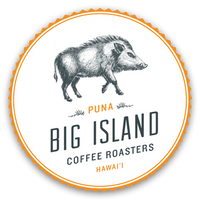Ka’u’s terrain is incredibly diverse. Most Ka'u coffee is produced in a few mountainous pockets above the town of Pahala on the flanks of Mauna Loa, basically in the center of the Ka’u district. To the southwest, sweeping grass and pasture lands extend from just about sea level to the foothills. To the northeast is a long stretch of arid, lava-crusted landscape until the elevation climbs up to the cool and rainy Volcanoes National Park at 4300’. In the middle, cattle, macadamia nut trees and coffee cohabitate with the land and people.
Ironically, the largest district on the Big Island -- larger than the entire island of Oahu -- houses a population of under 10,000 scattered people. 35% are Filipino and / or Hawaiian natives, descendants of fieldworkers for the sugar industry. Most of them are older, farm-type folks who grew up working the cane fields, or “King Sugarcane.” Now, people work on ranches, coffee fields, and orchards up near the hills during the day and return to the towns of Pahala, Na’alehu and Waiohinu, living their weeknights and weekends halfway between the ocean and work.
Ka’u feels slow and sleepy. For the most part, it is. But holidays are always raucous. Neighbors and relatives get together, cook big meals, drink beer, feast, light fireworks and shoot guns in the air. Both quaint and a skosh surly.
Coffee was first cultivated in Ka‘u in 1894 by J.C. Searle. However, his coffee business was not commercially successful due to the competition for land and labor posed by the sugar plantations. When the sugar industry collapsed one hundred years later, and the Ka‘u sugar plantation closed in 1996, the displaced plantation workers looked to coffee as one of the most promising avenues for post-plantation agriculture. The first years of the fledgling Ka‘u coffee industry were rife with challenges as the farmers struggled to acquire the daunting array of agricultural, processing and business skills required to succeed in the modern coffee industry.
In the early years, Ka’u coffee was largely sold into the Kona market with little recognition for Ka’u growers. Ka‘u coffee slowly began to develop its own brand identity among local coffee buffs but remained virtually unknown outside the region until recent years. This change began in 2007, when Ka‘u coffees were entered in the Specialty Coffee Association of America’s annual competition. Since then, Ka‘u coffee farmers have won numerous awards.
The two coffees comprising of our Ka'u Morning Glory come from farms planted in 1998, in an area aptly named “Cloud Rest”. Deep, rich soil, morning sun and afternoon clouds and rain define this pocket of land. The coffee seems to really enjoy it, too. These coffees are usually purchased in bulk with several other Ka’u coffee lots and then all mixed together to be sold as green bean for Starbucks’ Reserve line. This is due to stipulations of the lease agreement: a certain portion of the farmers’ crop must be sold to the landowners every season, who broker the coffee to Starbucks.
While we have the opportunity to cup, taste, and select coffees from throughout Ka'u, other folks rarely do. So, here, we'd like to introduce you to two farmers and the tasting notes in their individual coffees, which make up our Ka'u Morning Glory.
Leo’s been in the business for a while. Not only does he produce coffee on 30+ acres but he also sells the vast majority of the crop as roasted wholesale coffee under his private label. For the past year, we’ve been contract-roasting his best stuff for his discerning, high-end clients. This year, he offered to sell us his parchment (which he never does) because, as he put it, “you’ve helped me out so I want to help you out.” We responded with gratitude and excitement, “We’ll buy as much as you’re willing to sell.”
Leo’s coffee consistently places in the top 10 of Hawaii’s statewide cupping competition and for good reason: it’s damn good. We love his attention to detail and emphasis on quality with respect to cultivation, harvesting and processing, which is quite rare.
Tasting notes: A full, rich, nutty and malty cup with pecan and caramel sweetness and notes of poached apple, butter, and spice. For lack of a better term, “masculine” comes to mind as a point of distinction when compared directly next to the Marques' coffee.
Francis & Trinidad Marques
This lovely couple were both born and raised in Pahala, spending much of their lives in the cane fields working for the Ka’u sugar plantation. Their coffee has placed very well in numerous competitions. Last year, they topped the score chart of the Hawai’i statewide cupping competition. In 2012, they placed 7th in the prestigious Specialty Coffee Association’s “Coffees of the Year” competition, which selects the top ten coffees in the world.
Typically, they sell their coffee green to Starbucks (who subsequently roasts their excellent coffee in unfortunate ways) or it’s roasted and sold under their private label. They had a heavy harvest this year so they've been open to selling “parchment”, the trade term for dried green coffee with the exterior husk still attached.
Tasting notes: A bit more delicate than Leo’s but still full-bodied. Flavors of brown sugar and almond sweetness are brightened with fruit notes of cherry, strawberry and vanilla.




